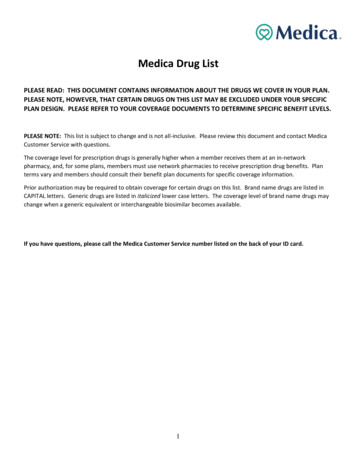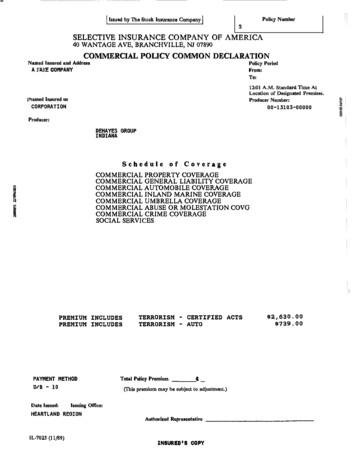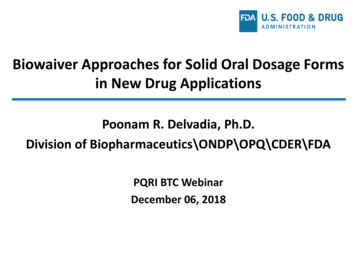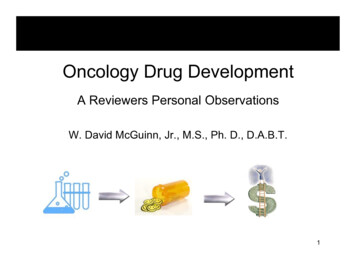
Transcription
Theranostics 2020, Vol. 10, Issue 3IvyspringInternational PublisherResearch Paper1166Theranostics2020; 10(3): 1166-1180. doi: 10.7150/thno.38627Selective Intratumoral Drug Release and SimultaneousInhibition of Oxidative Stress by a HighlyReductive Nanosystem and Its Application asan Anti-tumor AgentChunqi Zhu1, Lihua Luo1, Xindong jiang1, Mengshi Jiang1, Zhenyu Luo1, Xiang Li1, Weigen Qiu1, ZhaoleiJin1, Tianxiang Shen1, Chunlong Li1, Qingpo Li1, Yunqing Qiu2 and Jian You1 1.2.College of Pharmaceutical Sciences, Zhejiang University, 866 Yuhangtang Road, Hangzhou, Zhejiang 310058, P. R. China;State Key Laboratory for Diagnosis and Treatment of Infectious Diseases, Collaborative Innovation Center for Diagnosis and Treatment of InfectiousDiseases, The First Affiliated Hospital, Zhejiang University, 79 Qingchun Road, Hangzhou, Zhejiang 31003, P. R. China. Corresponding author: Jian You, College of Pharmaceutical Sciences, Zhejiang University, 866 Yuhangtang Road, Hangzhou 310058, Zhejiang, China. Office:086-571-88981651, Email: youjiandoc@zju.edu.cn. The author(s). This is an open access article distributed under the terms of the Creative Commons Attribution License (https://creativecommons.org/licenses/by/4.0/).See http://ivyspring.com/terms for full terms and conditions.Received: 2019.07.22; Accepted: 2019.10.30; Published: 2020.01.01AbstractExcessive oxidative stress is always associated with the serious side effects of chemotherapy. In thecurrent study, we developed a vitamin E based strongly reductive nanosystem to increase theloading efficiency of docetaxel (DTX, DTX-VNS), reduce its side toxicity and enhance the antitumoreffect.Methods: We used Förster Resonance Energy Transfer (FRET) to reveal the in vivo and in vitro fateof DTX-VNS over time. All FRET images were observed using the Maestro imaging system (CRI,Inc., Woburn, MA) and Fluo-View software (Olympus LX83-FV3000).Results: Through FRET analyzing, we found that our nanosystem showed a selective rapiderrelease of drugs in tumors compared to normal organs due to the higher levels of ROS in tumorcells than normal cells, and the accumulation of DTX at tumor sites in the DTX-VNS group was alsonotably more than that in the Taxotere group after 24 h injection. Meanwhile, DTX-VNS had aprominently stronger anti-tumor effect in various models than Taxotere, and had a synergistic effectof immunotherapy.Conclusions: Our work presented a useful reference for clinical exploration of the in vivo behaviorof nanocarriers (DTX-VNS), inhibition oxidative stress and selective release of drugs at tumor sites,thus reducing the side effects and enhancing the anti-tumor effects.Key words: Oxidative Stress; Docetaxel; Reductive nanosystem; Selective release; Systemic toxicity.IntroductionUnlike photodynamic therapy or onstrated to have strong antitumor activity in theclinic, but not because of the toxicity of large amountsof reactive oxygen species (ROS) that are produced incancer cells [1-4]. However, ROS-independentchemotherapy still exhibits obvious toxic side effectsduring the treatment process, which seriously restrictsits clinical application [5, 6]. Most of the mechanismsof these side effects are related to excessive oxidativestress in cells [7, 8], that is attributed to an intercellularimbalance between pro-oxidant and antioxidantfactors under the stimulation of the chemotherapeuticagents [9]. ROS have been associated with thehttp://www.thno.org
Theranostics 2020, Vol. 10, Issue 3principle of oxidative stress-mediated pathologicalphenomena, which occur when there is a net increasein ROS, and this net increase has been implicated incellulardamage,inflammationandneurodegeneration [10-12]. Moreover, much effort hasbeen invested in defining the role of ROS as atumor-promoting agent, with abundant evidencesupporting this argument [13, 14].Docetaxel (DTX), an antineoplastic agent, is amember of the second generation of the taxoid familyderived from the needles of the European yew treeTaxus baccata [15]. DTX is approximately twice aspotent as paclitaxel in inhibiting microtubuledepolymerization in vitro [16, 17]. DTX has been usedto treat a broad spectrum of solid tumors such asnon-small cell lung cancer, locally advanced ormetastatic breast cancer, and androgen-independentprostate cancer [18, 19]. However, DTX also causesserious side effects, such as hemolytic toxicity,myelosuppression, anemia, and hypersensitivityreactions, which limit its clinical applications [20-22].Because of its poor solubility, DTX requires theaddition of a substantial amount of surfactant(Tween) and ethanol in its commercial formulation(Taxotere, the only DTX preparation used in theclinic), which further increases the risk of systemictoxicity in cancer treatment [23].As a major lipid soluble antioxidant present inthe cell membrane, vitamin E plays an important roleas a chain-breaking lipid antioxidant and free radicalscavenger in the membrane of cells and subcellularorgans [24-26]. Vitamin E have been pursued as ananticancer agent because of its antioxidant properties,and it can also reduce ROS levels in tumor sites.Incomplete reduction of oxygen leads to the formationof the chemically more reactive species called ROS,including hydroxyl radicals, superoxide anions andother free radicals. Vitamin E mainly scavenges activefree radicals by a hydrogen atom transfer reaction,producing non-free radical products and vitamin Eradicals [27-29]. Moreover, it has been reported thatvitamin E may be a suitable candidate for theadjuvant treatment of cancer by antitumor immuneregulation [30-32]. It has been reported that vitamin Esupplements can enhance the Th1-type immuneresponse, while blocking the production of Th2cytokines in different disease states [33, 34].Currently, it is becoming a trend to ironment of tumors and by similarnanodosing strategies [35, 36]. Therefore, in this work,we expect to develop a highly reductive nanosystemloaded with DTX (DTX-VNS). Due to the regulatedimmune microenvironment, we hypothesized that thenanosystem could exhibit high antitumor efficacy,1167and synchronously reduce the imbalance of oxidativestress by eliminating the increased accumulation ofROS due to drug stimulation, resulting in decreasedside effects during treatment. In addition, the in vivofate of DTX-VNS over time after administration wasrevealed by Förster resonance energy transfer (FRET)analysis.Our nanosystem has a selective and morerapid release of drug in tumor sites than in normalorgans because of the higher levels of ROS producedin tumors. The current research explored the in vivobehavior of reductive nanocarriers, which inhibitedoxidative stress and selectively released drugs attumor sites, and this may provide a useful referencefor reducing the side effects and enhancing theefficacy of chemotherapeutic agents in the clinic.Materials and MethodsMaterialsDocetaxel (DTX) was purchased from FujianNanfang Pharmaceutical Co., Ltd. (Fujian, China);medium chain triglyceride (MCT), soybean lecithin(S100), vitamin E (VE, α-tocopheryloxyacetic acid),corn oil and soybean oil were purchased from LipoidCo. (Ludwigshafen, Germany). Dulbecco’s ModifiedEagle Medium (DMEM), Roswell Park MemorialInstitute (RPMI) 1640 medium, trypsin, fetal bovineserum (FBS) and penicillin/streptomycin (100 U/mL)were obtained from JiNuo Biotechnology Co., Ltd.(Zhejiang, China). mbromide(MTT)andHoechst33324 were acquired from Sigma-Aldrich Inc.(St Louis, MO, USA). EthD-1 and calcein AM(live/dead viability/cytotoxicity kit [L-3224]) werepurchased from Life Technologies (Carlsbad, CA,USA). 3,3′-dioctadecyloxacarbocyanine thylindocarbocyanine ethylindotricarbocyanine Iodide (DiR), propidium iodide (DiD), and NileRed (NR) were purchased from Invitrogen Co.(Carlsbad, CA, USA). Chemicals and solvents were ofanalytical grade and were used as received.Cell Culture and Animals4T1 (mouse breast carcinoma), A549 (humanpulmonary carcinoma), MDA-MB-231 (human breastcarcinoma), LO2 (human hepatocytes), NIH-3T3(mouse embryo fibroblast) and HEK 293 cell lineswere purchased from the Institute of Biochemistryand Cell Biology (Shanghai, China). Cells werecultured at 37 C in a humidified atmospherecontaining 5% CO2 in RPMI 1640 medium or DMEMsupplemented with 10% fetal bovine serum and 100U/mL penicillin and 100 U/mL streptomycin.All animal experiments were conducted inhttp://www.thno.org
Theranostics 2020, Vol. 10, Issue 3accordance with the National Institutes of HealthGuide for the Care and Use of Laboratory Animalswith the approval of the Scientific Investigation Boardof Zhejiang University.Preparation and Characteristics of DTX-VNSFirst, to obtain a nanosystem with high DTXencapsulation efficiency, the solubility of DTX indifferent oily materials was investigated. Briefly,excess DTX was added to distilled water (H2O), cornoil, soybean oil, MCT and VE, and then the mixtureswere shaken at room temperature for 48 hours [37].The concentration of DTX in the medium y (HPLC) [38].DTX-VNS were prepared by a high-energyemulsification method using high pressurehomogenization (HPH). Briefly, 30 mg of DTX wasdissolved in a mixed medium of VE, S100, and MCT(weight ratio of 2:1:1) to form an oil phase, which wasfurther dispersed in an aqueous phase containingsucrose. DTX-VNS was finally obtained by dispersingthe oil droplets into nanoscale-sized particles usingthe HPH method. DTX-NS (only DTX-loadednanosystems, without VE) were prepared by the samemethod.The mean droplet size and zeta potential ofDTX-VNS were measured by dynamic light scattering(DLS) with a Zetasizer (ZS90, Malvern Co., UK). Themorphology of DTX-VNS was observed bytransmission electron microscope (TEM, JEOLJEM-1230 microscopy at 120 kV; JEOL, Japan). Theencapsulation efficiency of DTX in the nanosystemwas measured by ultrafiltration method.Antitumor Activity in vivoThe antitumor efficacy was assessed on 4T1,MDA-MB-231 and A549 tumor models. The 4T1 andMDA-MB-231 tumor models were obtained byorthotropic injection of 4T1 or MDA-MB-231 cells (1 106) into the upper breast pad of each female BALB/cor nude mouse, respectively. A549 tumor modelswere established by subcutaneous injection of A549cells (1 106) into the right flank of each BALB/cmouse. Mice bearing different tumors were randomlydivided into four or five groups (n 5 per group) whenthe tumor diameters reached 50-100 mm3. The mice inthe different groups were intravenously injected withsaline, blank nanosystem (Blank VNS, no DTXloading), DTX-VNS (10 mg DTX/kg per injection),DTX-NS (10 mg DTX/kg per injection) or Taxotere (10mg DTX/kg per injection) for a total of 6 times(twice/per week), respectively. The tumor volumesand body weights of the mice were monitored. Aftertreatment, the tumors and major organs lin-eosin), Ki-67 or TUNEL staining.In vitro Synergistic Anticancer EffectsThe synergistic anticancer effect of DTX and VEwas first investigated using live & death cell staining.4T1 cells were incubated with Blank VNS, DTX-VNS,Taxotere or Taxotere plus VE (a mixture of Taxotereand VE at 1:10, weight ratio, the same ratio ofDTX/VE in DTX-VNS) at equivalent DTXconcentrations of 10 μg/mL, 5 μg/mL and 1 μg/mL.After incubation for 48 h, the cells were stained withcalcein AM and EthD-1 and then observed using afluorescence microscope (Nikon, Japan).4T1 cells were treated with DTX-VNS, Taxotereor Taxotere plus VE at the equivalent DTXconcentration of 10 μg/mL for 24 or 48 hours.Apoptosis of the cells was detected by an AccuriTM C6flow cytometer (FC500 MCL; Beckman Coulter,Miami, FL) after staining with an annexinV-fluorescein isothiocyanate apoptosis detection kit I(MultiSciences Biotech, Zhejiang, China) according tothe manufacturer’s instructions.For the cell cycle distribution study, 4T1 cellswere treated with Blank-VNS, DTX-VNS, Taxotere orTaxotere plus VE at the equivalent DTX concentrationof 0.5 μg/mL for 48 hours. The phase of cell cyclearrest was evaluated by flow cytometry usingpropidium iodide as a fluorescent marker [17, 39].Synergistic Effects from ImmunotherapyThe mice bearing 4T1 tumors were divided into 5groups (5 mice per group). The mice in groups 1-5were intravenously injected with saline, Blank-VNS(100 mg VE/kg), Taxotere (10 mg DTX/kg),DTX-VNS (10 mg DTX/kg and 100 mg VE/kg), andTaxotere (10 mg DTX/kg) plus VE (100 mg/kg) threetimesat a frequency of once a week. After thetreatments for three weeks, the mice were sacrificed,and the tumors, spleens and lymph nodes werecollected. Fresh tumor tissues were sliced to analyzeCD8 TcellsandIFN-γlevelsusingimmunofluorescence. T cells (CD3 , CD4 , andCD8 ) in the spleen and DC cells in lymph nodeswere isolated and analyzed using flow cytometry, andIL-4, IL-2 and IFN-γ in tumor and spleen tissues werealso examined using ELISA kits.Bone Marrow Toxicity and Hemolysis TestMyelosuppression toxicity is one of the mostcommon side effects of DTX. To investigate themyelosuppressiontoxicityofDTX-VNS,two-week-old SD rats were sacrificed, and the bonemarrow cells were isolated from the tibias. Then thecells (5 103 cells/well in MethoCult medium) weretreated with Blank-VNS, DTX-VNS, Taxotere orhttp://www.thno.org
Theranostics 2020, Vol. 10, Issue 3Taxotere plus VE at equivalent DTX concentrations of0.1, 1 and 10 μg/mL. Mock-treated cells were used asthe control (Ctrl). Cells were incubated at 37 C and5% CO2 for about approximately 14 days untilcolonies formed and the numbers were counted underthe observation of microscope after crystal violetstaining.For the hemolysis test, fresh blood was collectedfrom a healthy rabbit’s heart. The blood was dilutedwith saline (1:10, v/v) and centrifuged at 1300 rpm for15 min to separate the red blood cells. The cells insaline were further incubated with Blank-VN,DTX-VNS, Taxotere, Taxotere plus VE, or theDTX-loaded nanosystem without VE (DTX-NS) atvarious DTX concentrations. The cells treated withonly pure water and saline were used as positive andnegative controls, respectively. After 3 hours ofincubation at 37 C, the samples were centrifuged at3000 rpm for 5 min and the supernatants werecarefully collected for spectroscopic analysis at 545nm using an ultraviolet spectrophotometer(UNIC-7200, China). The hemolysis parameters n) 100%, where ODt, ODn andODp represent the optical densities of the test,negative and positive groups, respectively [40, 41].Selective Drug Release in vitroIn vitro DTX release assays were performed inmedia with varying concentrations of H2O2 (a mixtureof SDS and ethanol at a weight ratio of 1:5) usingdialysis bags (MWCO 3500 Da). An aqueousdispersion of DTX-VNS (1 mg in 0.5 mL) was placedinto the dialysis bags which were then placed inexcessive medium (40 mL) and incubated at 37 C withdifferent concentrations of H2O2 (1 μm, 0.1, 1, and 10mM). The release medium was collected atpredetermined intervals and replaced with an equalvolume of fresh medium. The release of DTX inDTX-NS was performed at a concentration of 0.1 mMH2O2.The DTX content in the release medium wasmeasured by HPLC analysis.Intracellular ROS DeterminationTo detect ROS accumulation in cells underdifferent treatments, 4T1 tumor or LO2 normal cellswere incubated with Blank-VNS, DTX-VNS, Taxotereor Taxotere plus VE at the equivalent DTXconcentration of 10 μg/mL for 48 hours. Cells with notreatment were used as controls (Ctrl). The cells werethen treated with DCFH-DA (10 μM) for 20 min todetect intracellular ROS. Then, the fluorescence of thesamples was examined with a fluorescencemicroscope.1169In vivo Acute ToxicityFor the acute toxicity study, SD rats (200-225 g)were divided into 6 groups (7 rats/group). The rats ingroups 1-6 were intravenously injected with saline,Blank-VNS, DTX-VNS (low dose, 8 mg DTX/kg),DTX-VNS (high dose, 16 mg DTX/kg), Taxotere (lowdose, 8 mg DTX/kg), and Taxotere (high dose, 16 mgDTX/kg) four times (once per week). The rats wereweighed and visual observations of mortality,behavioral patterns, changes in physical appearanceand signs of illness were conducted once daily duringthe period. At the end of the experiments, blood wascollected for biochemical and hematological analyses.Then, the rats were sacrificed, and the organs wereweighed to calculate the organ coefficient.Tolerance Dose StudyBALB/c mice were divided into 2 groups (3mice/group), and were intravenously injected withDTX-VNS (20 mg DTX/kg per injection) or Taxotere(20 mg DTX/kg per injection) for four weeks (twoinjections per week). Animal mortality was recordedduring the experiment. Then the animals continued tobe reared normally, and their recovery was assessedby visual observation.Selective Drug Release and ToxicityFor the selective drug release study, DiO and Dil(1:5 w/w) were co-encapsulated into DTX-VNS.Cancer (4T1, MDA-MB-231 and A549) and normalcells (LO2, HEK293 and NIH-3T3) were incubatedwith DiO and Dil labeled DTX-VNS for different time.FRET images were obtained using a fluorescencemicroscope (480 nm excitation, 490-520 nm emissionfor DiO and 560-650 nm for DiI). All images wereobtained and processed with Fluoview software(Olympus LX83-FV3000). The fluorescence intensityof the disintegrated and integrated DTX-VNS in cellswas calculated using ImageJ software.Selective drug release was further investigated inmice bearing various tumors (4T1, MDA-MB-231 andA549) after intravenous injection of DTX-VNS, whichwas colabeled with NR and DiD. At thepredetermined time point, mice were anesthetizedand FRET images were observed using the Maestroimaging system (CRI, Inc., Woburn, MA) (590 nmexcitation, 600-630 nm emission for NR and 670-700nm emission for DiD). Mice were then sacrificed, andthe main organs including tumors were collected andfurther imaged. The fluorescence intensities of thedisintegrated and integrated DTX-VNS in variousorgans 24 hours after injection were calculated usingImageJ. To investigate the role of VE in the selectiverelease of DTX-VNS, A549-bearing mice were injectedwith NR or DiD-loaded DTX-NS (no VE), and thehttp://www.thno.org
Theranostics 2020, Vol. 10, Issue 3fluorescence images were acquired.The toxicity of DTX-VNS to cancer and normalcells was determined by MTT assay according to themanufacturer's suggested procedures. A549, 4T1,MDA-MB-231, LO2, NIH 3T3 and HEK 293 cells wereexposed to DTX-VNS or Taxotere for 48 hours. Thedata are expressed as the percent of surviving cellsand are reported as the mean values of 5measurements.Biodistribution StudyA 4T1 tumor model, generated by thesubcutaneous injection of 1 xX106 cells in 100 μL ofPBS into the right rear flanks of male BALB/c mice(aged 6-8 weeks), was employed for imaging. Whenthe tumors reached approximately 200 mm3 in size,the mice bearing 4T1 tumors were injected via the tailvein with DiR-loaded VNS. The mice were opticallyimaged using an in vivo imaging system (CambridgeResearch & Instrumentation, Inc., Woburn, MA) atpredetermined times after the injection. At the end ofthe experiment, the mice were sacrificed. Varioustissues, including the tumors were collected, weighed,and observed by the in vivo imaging system, and thefluorescence intensity of DiR was also obtained. Theaccumulation of DiR in various tissues was calculatedas the signal-to-weight ratio and expressed as themean SD.Mice bearing MDA-MB-231 tumors weredivided into 2 groups (6 mice/group) andintravenously injected with DTX-VNS or Taxotere at aDTX dose of 10 mg/kg. At 24 hours postinjection, the1170mice were sacrificed, and the main organs includingthe tumors, were collected and homogenized. TheDTX content in various organs was analyzed byHPLC-MS after DTX extraction from the homogenate[42].StatisticsStatistically significant differences betweenmultiple values were determined with ANOVA,followed by Tukey–Kramer tests. Differences betweenpairs of groups were analyzed by Student's t-test, andP-values 0.05 were considered statisticallysignificant.ResultsPreparation and Characterization ofDTX-VNSThe solubility of DTX in different media at roomtemperature was investigated. Among the mediatested, DTX presented the highest solubility in VE,which would facilitate the efficient encapsulation ofDTX into VE-based nanosystems (data not shown)[37], and DTX-VNS demonstrated a highencapsulation efficiency for DTX (97.45 0.96%). OurDTX-VNS had a mean diameter of 107.5 1.8nm, asdetermined by DLS (Figure 1A), as well as a negativesurface charge (-37.1 1.2 mV) (Figure 1B). TEMshowed complete spherical morphology and a smoothDTX-VNS surface of (Figure 1C). The stability of theDTX-VNS is presented at Table S1.Figure 1. Characteristics of DTX-VNS. Size distribution (A) and Zeta Potential (B) of DTX-VNS. (C) TEM images of DTX-VNS.http://www.thno.org
Theranostics 2020, Vol. 10, Issue 31171Figure 2. In vivo anticancer activity. Tumors growth curves for the mice bearing 4T1 tumors (A), MDA-MB-231 tumors (B) and A549 tumors (C) aftertreatment. *p 0.05, **p 0.01, ***p 0.005. (D) Average tumor weight of each group of 4T1 tumor model at the end of the study. Representative TUNEL and Ki-67staining images (E) and quantitative analysis (F) of 4T1 tumor tissues for four groups; the scale bar is 100 μm.In vivo Anticancer ActivityThe antitumor activity of DTX-VNS was tested in4T1, MDA-MB-231, and A549 tumor models.Surprisingly, DTX-VNS showed a significantlystronger ability than Taxotere to inhibit the growth ofthree kinds of tumors under the same DTX dose(Figure 2A-C). At the end of the experiment, thetumors from each group were collected. The averagetumor weight in the DTX-VNS group was the smallestamong the groups, further demonstrating the strongerantitumor efficacy of our nanosystem (Figure 2D, S1).The 4T1 tumor in the DTX-VNS group showed moreserious cancer cell apoptosis and a significantdecrease in proliferative activity (Figure 2E-F). Inaddition, normal tissues did not show significantdamage or inflammation (Figure S2A), and there wasno significant loss in body weight throughout theexperiment (Figure S2B), which suggested lowsystemic toxicity of DTX-VNS. To explicitly excludethe possible effects of the nanovehicles, we also usedDTX-NS as a control. From the results in figure S3, wecan see that the anti-tumor effects of nanoparticulateDTX (DTX-NS) and Taxotere were essentially thesame and were not as good as those observed forDTX-VNS. Our nanosystem exhibited significantlyenhanced anti-tumor activity, driving a series ofstudies further implemented to reveal the possiblemechanism.Cancer Cell Killing ActivityCompared to Taxotere, DTX-VNS exhibitedenhanced cancer cell killing effects under a cellincubation concentration of 1-10 μg/mL, as analyzedby live & death cell staining. This result should beattributed to the fact that VE was contained in thenanosystem, because the killing activity of Taxoterealso slightly increased when it was combined with VE(Figure 3A-B). These results were further confirmedby a cell apoptosis assay using flow cytometry afterthe double staining of PI and annexin V, whichshowed that VE causes a small increase in apoptosis(Figure 3C-D). Cell cycle profiles were also analyzedby flow cytometry after propidium iodide staining.Treatments with DTX-VNS, Taxotere and Taxotereplus VE for 48 hours caused similar cell cycle arrest inthe G2-M phase, which presented a DTX ization and destroying the mitosis ofcancer cells. Treatment with Blank-VNS did notexhibit similar anti-cancer characteristics and wassimilar to saline treatment (Figure 3E). These resultsindicated that although VE could help DTX exert astronger cancer cell killing effect, it did not contributeto the improvement of the direct lethality.http://www.thno.org
Theranostics 2020, Vol. 10, Issue 31172Figure 3. In vitro anticancer activity. Imaging (A) and quantitative analysis (B) based on the imaging of the dead (red) and live (green) cell assay with exposureof the 4T1 cells to different dose of Blank VNS, DTX-VNS, Taxotere, and Taxotere plus VE; the scale bar is 100 μm. Dot plot representing level (C) and quantitativeanalysis (D) of apoptosis after treating 4T1 cells with DTX-VNS, Taxotere, and Taxotere plus VE at equivalent drug concentration 10 μM for 24 hours (up) and 48hours (down). *p 0.05, **p 0.01, ***p 0.005. (E) Cell cycle phase distribution of 4T1 cells after treatment for 48 h, the concentration of DTX was 0.5 μg/mL.Synergistic Immunotherapy EffectVitamin E has been reported to exhibit anantitumor immune effect, for example by enhancingthe Th1-type immune response and hindering Th2cytokine production [43, 44]. The numbers of CD3,CD8 and CD4-positive T cells in the spleen andCD11c-, CD86- and MHC II- positive DC cells in thelymph nodes were measured and presented strongerproliferation in the DTX-VNS and Taxotere plus VEgroups than in the other groups (Figure 4A-D, E-H).The mice bearing 4T1 tumors were sacrificed aftervarious treatments, and the tumors were sliced for theanalysis of IFN-γ levels and the infiltration ofCD8-positive cytotoxic T lymphocytes (CD8 CTL). VEalone (Blank-VNS group) or DTX alone (Taxoteregroup) caused only a slight increase in IFN-γ levelsand CD8 CTL infiltration in the tumors, comparedwith the saline group. Interestingly, the levels of bothIFN-γ and CD8 CTL were significantly improved inthe tumors after treatment with a combination of DTXand VE, as presented in the DTX-VNS and Taxotereplus VE groups (Figure 4I-J). Furthermore, theimmune responses of Th1 and Th2 were furthermonitored in the tumor and spleen using ELISA aftertreatments. The Th1 immune response wassignificantly upregulated through an increase in thesecretion of IL-2 and IFN-γ, while the Th2 responsewas obviously downregulated, as evidenced by asignificant reduction in IL-4 secretion in the DTX-VNSand Taxotere plus VE groups (Figure 4K-L). Theresults indicated that, compared to VE or DTX alone,VE with the help of DTX chemotherapy could moreefficiently enhance the immune response that occursin the tumor microenvironment, which may be a mainreason why DTX-VNS exhibited significantlyenhanced anti-tumor activity.Myelosuppression and Hemolytic ToxicityMyelosuppression is a common side effectcaused by clinical chemotherapy. Primary mousebone marrow cells were isolated and treated withBlank-VNS, DTX-VNS, Taxotere or Taxotere plus VE.Then, the CFUs were counted under a microscope,including CFU-GMs (the colonies that contained 30 tothousands of granulocytes, macrophages, or both celltypes), erythroid progenitors (BFU-Es, made up oferythroid clusters and a minimum of 30 cells), andCFU-GEMMs (which tend to produce large coloniesof 500 cells containing erythroblasts and recognizablecells of at least two other lineages). Taxotere caused asignificant decrease in the amount of CFU-GMs,BFU-Es and CFU-GEMMs after incubation with aconcentration of 0.1-10 μg/mL DTX. However, in thesame concentration range, the degree of decline of theCFUs after the treatment with of DTX-VNS orTaxotere plus VE was greatly reduced (Figure 5A-Band S4A-C). These results indicated that, unlikeTaxotere alone, DTX-VNS could efficiently alleviatethe myelosuppressive toxicity caused by DTX, whichhttp://www.thno.org
Theranostics 2020, Vol. 10, Issue 3should be attributed to the role of VE in thenanosystems.The hemolytic potential of DTX-VNS wasassessed using fresh RBCs in DTX concentrationrange of 1-10 μg/mL. In the low DTX concentrationrange of 1-5 μg/mL, similar to Blank-VNS, DTX-VNSdid not cause significant hemolytic toxicity. Even atthe highest DTX concentration of 10 μg/mL, only11737.53% hemolysis occurred. However, at the sameconcentration of 10 μg/mL, DTX-NS (no VE) andTaxotere alone exhibited obviously increased levels ofhemolysis (39.69 1.14% and 42.89 2.05%,respectively) (Figure 5C-D and S4D). These datademonstrated that DTX-VNS had significantlyreduced hemotoxicity compared to Taxotere.Figure 4. In vivo synergetic immunotherapy effects. (A) Representative flow cytometry plots showing different groups of T cells in splenic lymphocytes.Representative flow cytometry plots showing (B) CD4 , CD8 T cells, (C) CD86 DC cells and (D) MHC II DC cells in lymph node lymphocytes. (E-H)Quantitation based on the results in panel A-D. (I) Immunoflorescence was used to examine IFN-γ (upper) and CD8 CTL (lower) in tumor sections at the end oftreated with Saline, Blank VNS, DTX-VNS, Taxotere, and Taxotere plus VE (red IFN-γ-positive cells; green, CD8 CTL-positive cells; blue, cell nuclei); the scale baris 100 μm. (J) The fluorescence intensity of CD8 CTL and IFN-γ in tumors was calculated based on (I) using ImageJ. IL-4, IL-2, and IFN-γ levels in the splenic tissues(K) and tumor tissues (L) of each group of mice isolated at the end of different treatments detected using ELISA. *p 0.05, **p 0.01, ***p 0.005. The errorrepresents the standard deviation from the mean (n 5).http://www.thno.org
Theranostics 2020, Vol. 10, Issue 31174Figure 5. The detoxification of DTX-VNS. (A) Bone marrow cells from mice were incubated Blank VNS, DTX-VNS, Taxotere, and Taxotere plus VE at thedose of 0.1 μg/mL, 1 μg/mL or 10 μg/mL for 14 days in methylcellulose-based media. Mock-treated cells were used as the control; the scale bar is 50 μm. (B)CFU-GMs Colonies of colony-forming units that generate granulocytes and macrophages were counted using an inverted microscope. (C) Photographs ofdefibrinated blood mixed with Blank VNS, DTX-VNS, Taxotere plus VE, DTX-NS, and Taxotere in middle concentration (5 μg/mL) for 3 hours. (D) Percentagehemolysis observed after incubating differe
Apoptosis of the cells was detected by an AccuriTM C6 flow cytometer (FC500 MCL; Beckman Coulter, Miami, FL) after staining with an annexin V-fluorescein isothiocyanate apoptosis detection kit I (MultiSciences Biotech, Zhejiang, China) according to the manufacturer's instructions. For the cell cycle distribution study, 4T1 cells










